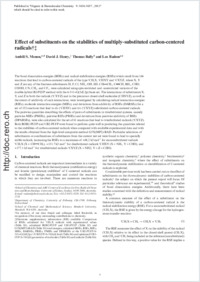Effect of substituents on the stabilities of multiply-substituted carbon-centered radicals
- Menon, Ambili S. Department of Chemistry, University of Fribourg, Switzerland
- Henry, David J. School of Chemical and Mathematical Sciences, Murdoch University, Australia
- Bally, Thomas Department of Chemistry, University of Fribourg, Switzerland
- Radom, Leo School of Chemistry and ARC Center of Excellence for Free Radical Chemistry and Biotechnology, University of Sydney, Australia
-
31.03.2011
Published in:
- Organic & Biomolecular Chemistry. - 2011, vol. 9, p. 3636-3657
English
The bond dissociation energies (BDEs) and radical stabilization energies (RSEs) which result from 166 reactions that lead to carbon-centered radicals of the type ˙CH₂X, ˙CHXY and ˙CXYZ, where X, Y and Z are any of the fourteen substituents H, F, Cl, NH₂, OH, SH, CH=CH₂, C≡CH, BH₂, CHO, COOH, CN, CH₃, and CF₃, were calculated using spin-restricted and -unrestricted variants of the double-hybrid B2-PLYP method with the 6-311+G(3df,2p) basis set. The interactions of substituents X, Y, and Z in both the radicals (˙CXYZ) and in the precursor closed-shell molecules (CHXYZ), as well as the extent of additivity of such interactions, were investigated by calculating radical interaction energies (RIEs), molecule interaction energies (MIEs), and deviations from additivity of RSEs (DARSEs) for a set of 152 reactions that lead to di- (˙CHXY) and tri- (˙CXYZ) substituted carbon-centered radicals. The pairwise quantities describing the effects of pairs of substituents in trisubstituted systems, namely pairwise MIEs (PMIEs), pairwise RIEs (PRIEs) and deviations from pairwise additivity of RSEs (DPARSEs), were also calculated for the set of 61 reactions that lead to trisubstituted radicals (˙CXYZ). Both ROB2-PLYP and UB2-PLYP were found to perform quite well in predicting the quantities related to the stabilities of carbon-centered radicals when compared with available experimental data and with the results obtained from the high-level composite method G3X(MP2)-RAD. Particular selections of substituents or combinations of substituents from the current test set were found to lead to specially stable radicals, increasing the RSEs to a maximum of +68.2 kJ mol⁻¹ for monosubstituted radicals ˙CH₂X (X = CH≡CH₂), +131.7 kJ mol⁻¹ for disubstituted radicals ˙CHXY (X = NH₂, Y = CHO), and +177.1 kJ mol⁻¹ for trisubstituted radicals ˙CXYZ (X = NH2, Y = Z = CHO).
- Faculty
- Faculté des sciences et de médecine
- Department
- Département de Chimie
- Language
-
- English
- Classification
- Chemistry
- License
- License undefined
- Identifiers
-
- RERO DOC 22484
- DOI 10.1039/C1OB05196B
- Persistent URL
- https://folia.unifr.ch/unifr/documents/301878
Other files
Statistics
Document views: 54
File downloads:
- bal_ess.pdf: 191
- bal_ess_sm.pdf: 117

